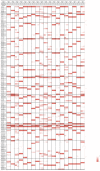Complexity of Human Cytomegalovirus Infection in South African HIV-Exposed Infants with Pneumonia
- PMID: 35632596
- PMCID: PMC9147013
- DOI: 10.3390/v14050855
Complexity of Human Cytomegalovirus Infection in South African HIV-Exposed Infants with Pneumonia
Abstract
Human cytomegalovirus (HCMV) can cause significant end-organ diseases such as pneumonia in HIV-exposed infants. Complex viral factors may influence pathogenesis including: a large genome with a sizeable coding capacity, numerous gene regions of hypervariability, multiple-strain infections, and tissue compartmentalization of strains. We used a whole genome sequencing approach to assess the complexity of infection by comparing high-throughput sequencing data obtained from respiratory and blood specimens of HIV-exposed infants with severe HCMV pneumonia with those of lung transplant recipients and patients with hematological disorders. There were significantly more specimens from HIV-exposed infants showing multiple HCMV strain infection. Some genotypes, such as UL73 G4B and UL74 G4, were significantly more prevalent in HIV-exposed infants with severe HCMV pneumonia. Some genotypes were predominant in the respiratory specimens of several patients. However, the predominance was not statistically significant, precluding firm conclusions on anatomical compartmentalization in the lung.
Keywords: HIV; compartmentalization; genotype; human cytomegalovirus; multiple-strain infections; pneumonia; whole genome sequence.
Conflict of interest statement
The authors declare no conflict of interest. The funders had no role in the design of the study; in the collection, analyses, or interpretation of data; in the writing of the manuscript; or in the decision to publish the results.
Figures

References
-
- Mocarski E.S. Cytomegaloviruses. In: Knipe D.M., editor. Fields Virology. Volume 2. Lippincott Williams and Wilkins; Philadelphia, PA, USA: 2007. pp. 2702–2772.
-
- Manicklal S., van Niekerk A.M., Kroon S.M., Hutto C., Novak Z., Pati S.K., Chowdhury N., Hsiao N.Y., Boppana S.B. Birth prevalence of congenital cytomegalovirus among infants of HIV-infected women on prenatal antiretroviral prophylaxis in South Africa. Clin. Infect. Dis. 2014;58:1467–1472. doi: 10.1093/cid/ciu096. - DOI - PubMed
-
- Mwaanza N., Chilukutu L., Tembo J., Kabwe M., Musonda K., Kapasa M., Chabala C., Sinyangwe S., Mwaba P., Zumla A., et al. High rates of congenital cytomegalovirus infection linked with maternal HIV infection among neonatal admissions at a large referral center in sub-Saharan Africa. Clin. Infect. Dis. 2014;58:728–735. doi: 10.1093/cid/cit766. - DOI - PubMed
Publication types
MeSH terms
Grants and funding
LinkOut - more resources
Full Text Sources
Medical

